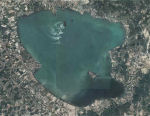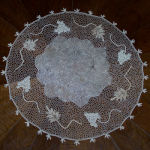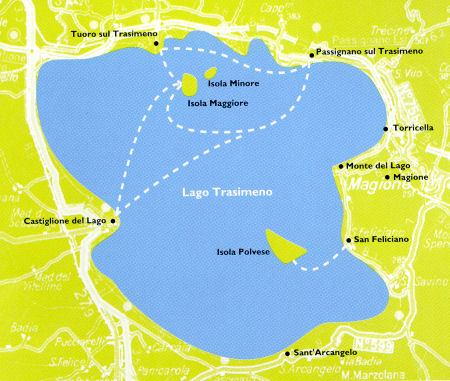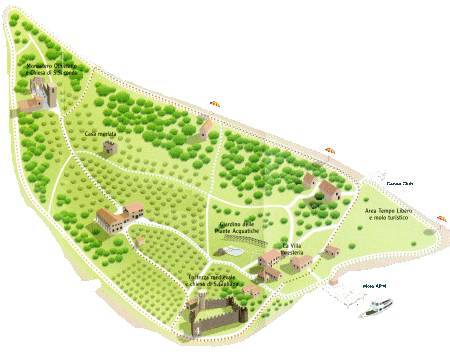With a surface of 128 square Km and circumference of 45 km, the Lake Trasimeno is the greatest of the central and southern Italy and the fourth of the whole country. It has a tectonic origin, is made of laminar layers and is maximum depth if of above 6 meters.
The lake is fed by some streams, ditches and, canals realized at the end of nineteenth century in order to risolve the problem of the cyclic flooding The Lake Trasimeno is located in the communal territories of Castiglione del Lago, Magione; Panicale, Passignano sul Trasimeno and Tuoro sul Trasimeno.
Three islands rises from its waters: the Minore, the Maggiore and the Polvese, connected to the main coasts centre by the boats of the Servizio Provinciale di. Navigazione del Trasimeno.
 The lake Trasimeno |
Isola Minore We have very scarce historical data for this isle, the smallest of the three rising from the lake called "isoletta" (small isle) until the beginnings of the twentieth century now it is part of the territory of Passignano is private and deserted.
Isola Maggiore. Set in the communal territory of Tuoro it is the only inhabited isle. It is, indeed, a picturesque village, where motor-vehicles are not allowed to circulate, inhabited by about forty families essentially living with the proceeds of traditional works as fishing and lace.
In summer, regular boats from the lakeshore jetty make the trip out to Isola Maggiore, one of the lake's three islands, a fun ride if you don't mind the crowds. The crossing takes twenty minutes, and there are connecting boats to Tuoro and Passignano, as well as to lesser resorts on the lake's southern and eastern shores.
Once over, there's a single village - known for its lace - and a pretty walk round the island perimeter.
 The lace of the island |
The island is famed for a visit by Saint Francis, a forty-day sojourn during which he consumed just half a loaf of bread; a chapel marks the point of his disembarkation, and there's a small Franciscan monastery on the southeast shore. The best outing, though, is to the church of San Arcangelo; sited at the island's highest point, it's decorated with frescoes and has a Crucifixion painted by Bartolomeo Caporali in 1460.
- Lace Museum - Opere Pie Building
Records of Isola Maggiore's traditions. Exhibition of antique and modern "Irish Point" lace. - Isola Maggiore Documentation Centre - Casa del, Capitano del Popolo 14thcentury
Historical, architectural and environmental reconstruction of the popular area, the port and the economic activities. Inside, painting on wooden panel by Sano di Pietro, Sienese School of the 15th century - Church of San Michele Arcangelo 12thcentury
Wooden Crucifix by B. Caporali, 15thcentury. Frescoes by the Umbrian School of the 13/15 centuries - Church of San Salvatore 12thcentury
Church in Roman Gothic style with three naves. It was built about 1155 during the n of Frederik I nicknamed Barbarossa. His effigy in sand stone was set Min the facade. (Booking is essential)
 |
Isola Polvese: a scientific and educational park. The isle is situated in the communal territory of Castiglione del Lago and is the largest of the three, with its 540.000 square meters. It is owned by the Provincia di Perugia and is a public park. Until the fifties the isle was inhabited by a large community, now is deserted. It conserves interesting historical monuments, as the Saint Secondo Monastery, the Church of Saint Julian and a castle of the fourteenth century. A recently built villa, the guests quarters and other buildings are now the seat of scientific educational and recreation activities.
The Polvese has been proclaimed by its owner, the Provincia di Perugia, a "Scientific Educational Park" devoted to research, experimentation, formative and educational activities in the environmental field.
 |
In the island there is an aquatic garden realized to the architectonic recovery of the swimming pool planned in 1959 by the roman architect Pietro Porcinai, in an old abandoned sandstone quarry. Around the largest central pool there are smaller basins in the shape of waterlillies, placed at different heights, where there are various species of aquatic plants from various origins. A large olive grove encircles the pool.
 The island with the castle of the 14th century |
 The tower of the castle |
|
 The tower of the castle |
 The aquatic garden |
Timetable of the boats: https://www.fsbusitalia.it/content/fsbusitalia/it/umbria/orari-linee-umbria/orari-servizi-navigazione-umbria.html
Know the island: https://www.provincia.perugia.it/aree-tematiche/patrimonio/isola-polvese
Information:
- Isola Polvese Turismo Natura Arte Cultura - Le proposte dell'Aula Verde - Centro di Esperienza Ambientale:
- CEA Isola Polvese - +39 3478489578 - info@plestina.it
- Ufficio Informazioni ed Accoglienza Parco Isola Polvese - telephone number 0039/0759659544/5 - 0039/075953837 – fax 0039/075951003
